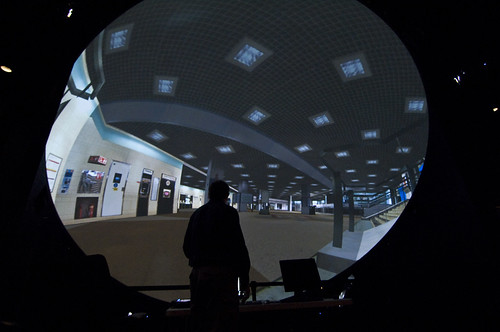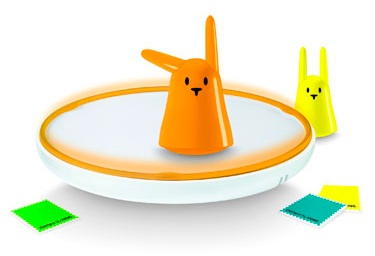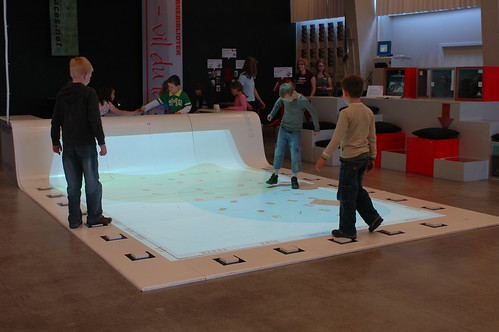I came across an excellent overview of interactive display technologies that hold promise for education. The link below is a research article written by Michael Haller for BECTA, formally known as the British Educational Communications and Technology Agency.Emerging Technologies for Learning: Interactive Displays and Next Generation Interfaces(pdf)
Becta Research Report (2008) Michael Haller Volume 3 (2008)"Multi-touch and interactive surfaces are becoming more interesting, because they allow a natural and intuitive interaction with the computer system.
These more intuitive and natural interfaces could help students to be more actively involved in working together with content and could also help improve whole-class teaching activities. As these technologies develop, the barrier of having to learn and work with traditional computer interfaces may diminish.
It is still unclear how fast these interfaces will become part of our daily life and how long it will take for them to be used in every classroom. However, we strongly believe that the more intuitive the interface is, the faster it will be accepted and used. There is a huge potential in these devices, because they allow us to use digital technologies in a more human way." -Michael HallerMichael Haller works at the department of Digital Media of the Upper Austria University of Applied Sciences (Hagenberg, Austria), where he is the head of the Media Interaction Lab.Michael co-organized the Interaction Tomorrow course at SIGGRAPH 2007, along with Chia Shen, of the Mitsubishi Electric Research Laboratories (MERL). Lecturers included Gerald Morrison, of Smart Technologies, Bruce H. Thomas, of the University oof Southern Australia, and Andy Wilson, of Microsoft Research. The course materials from Interaction Tomorrow are available on-line, and include videos, slides, and course notes.Below is an excerpt from the discription of the Interaction Tomorrow SIGGRAPH 2007 course:
"Conventional metaphors and underlying interface infrastructure for single-user desktop systems have been traditionally geared towards single mouse and keyboard-based WIMP interface design, while people usually meet around a table, facing each other. A table/wall setting provides a large interactive visual surface for groups to interact together. It encourages collaboration, coordination, as well as simultaneous and parallel problem solving among multiple people.
In this course, we will describe particular challenges and solutions for the design of direct-touch tabletop and interactive wall environments. The participants will learn how to design a non-traditional user interface for large horizontal and vertical displays. Topics include physical setups (e.g. output displays), tracking, sensing, input devices, output displays, pen-based interfaces, direct multi-touch interactions, tangible UI, interaction techniques, application domains, current commercial systems, and future research."
It is worth taking the time to look over Haller's other publications. Here is a few that would be good to read:
M. Haller, C. Forlines, C. Koeffel, J. Leitner, and C. Shen, 2009. "Tabletop Games: Platforms, Experimental Games and Design Recommendations." Springer, 2009. in press [bibtex]
A. D. Cheok, M. Haller, O. N. N. Fernando, and J. P. Wijesena, 2009.
"Mixed Reality Entertainment and Art," International Journal of Virtual Reality, vol. X, p. X, 2009. in press [bibtex]
J. Leitner, C. Köffel, and M. Haller, 2009. "Bridging the gap between real and virtual objects for tabletop games," International Journal of Virtual Reality, vol. X, p. X, 2009. in press [bibtex]
M. Haller and M. Billinghurst, 2008.
"Interactive Tables: Requirements, Design Recommendations, and Implementation." IGI Publishing, 2008. [bibtex]
D. Leithinger and M. Haller, 2007. "Improving Menu Interaction for Cluttered Tabletop Setups with User-Drawn Path Menus," Horizontal Interactive Human-Computer Systems, 2007. TABLETOP 07. Second Annual IEEE International Workshop on, pp. 121-128, 2007. [bibtex] J. Leitner, J. Powell, P. Brandl, T. Seifried, M. Haller, B. Dorray, and P. To, 2009."Flux: a tilting multi-touch and pen based surface," in CHI EA 09: Proceedings of the 27th international conference extended abstracts on Human factors in computing systems, New York, NY, USA, 2009, pp. 3211-3216. [bibtex]
P. Brandl, J. Leitner, T. Seifried, M. Haller, B. Doray, and P. To, 2009. "Occlusion-aware menu design for digital tabletops," in CHI EA 09: Proceedings of the 27th international conference extended abstracts on Human factors in computing systems, New York, NY, USA, 2009, pp. 3223-3228. [bibtex] References from the BECTA paper:Elrod, S., Bruce, R., Gold, R., Goldberg, D., Halasz, F., Janssen, W., Lee, D., Mc-Call, K., Pedersen, E., Pier, F., Tang, J., and Welch, B., Liveboard: a large interactive display supporting group meetings, presentations, and remote collaboration, CHI ’92 (New York, NY, USA), ACM Press, 1992, pp. 599–607.
Morrison, G., ‘A Camera-Based Input Device for Large Interactive Displays’, IEEE Computer Graphics and Applications, vol. 25, no. 4, pp. 52-57, Jul/Aug, 2005.
Albert, A. E. The effect of graphic input devices on performance in a cursor positioning task. Proceedings ofthe Human Factors Society 26th Annual Meeting, Santa Monica, CA: Human Factors Society, 1982, pp. 54-58.
Dietz, P.H., Leigh, D.L., DiamondTouch: A Multi-User Touch Technology, ACM Symposium on User Interface Software and Technology (UIST), ISBN: 1-58113-438-X, pp. 219-226, November 2001.
Rekimoto, J., SmartSkin: An Infrastructure for Freehand Manipulation on Interactive Surfaces,
CHI 2002, 2002.
Kakehi, Y., Iida, M., Naemura, T., Shirai, Y., Matsushita, M.,Ohguro, T., ‘Lumisight Table: Interactive View-Dependent Tabletop Display Surrounded by Multiple Users’, In IEEE Computer
Graphics and Applications, vol. 25, no.1, pp 48 – 53, 2005.
Streitz, N., Prante, P., Röcker, C., van Alphen, D., Magerkurth, C.,Stenzel, R., ‘Ambient Displays and Mobile Devices for the Creation of Social Architectural Spaces: Supporting informal communication and social awareness in organizations’ in Public and Situated Displays: Social and Interactional Aspects of Shared Display Technologies, Kluwer Publishers, 2003. pp. 387-409.
Morrison, G., A Camera-Based Input Device for Large Interactive Displays, IEEE Computer Graphics and Applications, vol. 25, no. 4, pp. 52-57, Jul/Aug, 2005.
Ishii, H., Underkoffler, J., Chak, D., Piper, B., Ben-Joseph, E., Yeung, L. and Zahra, K., Augmented Urban Planning Workbench: Overlaying Drawings, Physical Models and Digital Simulation. IEEE and ACM International Symposium on Mixed and Augmented Reality ACM Press, Darmstadt, Germany.
Han, Y., Low-cost multi-touch sensing through frustrated total internal reflection, UIST ’05 (New York), ACM Press, 2005, pp. 115–118.
Hull., J., Erol, B., Graham, J., Ke, Q., Kishi, H., Moraleda, J., Olst, D., Paper-Based Augmented Reality. In Proceedings of the 17th International Conference on Artificial Reality and Telexistence (Esbjerg, Denmark,November 28-30, 2007). ICAT ’07. IEEE, 205-209.
Haller, M., Leithinger, D., Leitner, J., Seifried, T., Brandl, P., Zauner, J., Billinghurst, M., The shared design space. In SIGGRAPH ’06: ACM SIGGRAPH 2006 Emerging technologies, page 29, New York, NY,USA, 2006. ACM Press.
Research email: emtech@becta.org.uk
Main email: becta@becta.org.uk
URL: www.becta.org.uk
(This was also posted on the TechPsych blog.)







































